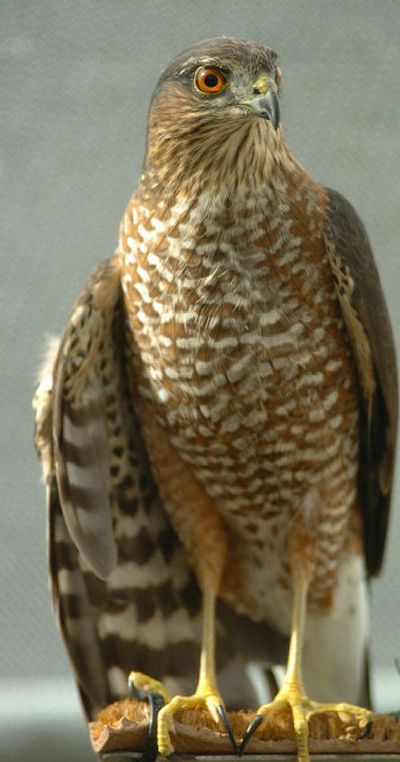Orphaned, injured animals get care

PENDLETON, Ore. – Lynn Tompkins carries trays of food to her guests at Blue Mountain Wildlife and they flutter and chatter at her arrival.
For some guests she spreads out mice and rats, complete with fur and tails. For others she offers quail and the occasional duck or pheasant, complete with feathers and feet.
A bald eagle may tear into a cold rat or fish without a by-your-leave, and a turkey vulture may pluck at a road-killed rabbit with no thought of tipping Tompkins for her service. Tompkins doesn’t mind. She expects no overt gratitude from the dozens of raptors that she feeds daily.
She’s satisfied that they’re healthy and living the best lives possible.
Few, if any, of those she feeds on a regular basis will ever return to the wild.
But if Tompkins and her husband, Bob, have their way, the raptors will have productive lives.
Lynn serves as the director of Blue Mountain Wildlife, a rehabilitation and education center near Pendleton. And Bob is the assistant director. It’s an around-the-clock job for them, and they wouldn’t have it any other way.
Lynn says the mission of Blue Mountain Wildlife is to provide necessary treatment and care for orphaned, injured or sick wildlife and to enable them to return to their natural habitat.
Bob said the center gives purpose to the lives of injured animals, most of which are birds of prey.
“We use them in our education programs, to let people better understand them and how they fit into the environment,” he said. “We keep them here for display, and we talk to people who come to see them.”
For a variety of reasons, most of the 65 or so raptors and two bobcats now at the Blue Mountain Wildlife facilities will not return to the wild.
Two great horned owls, for example, were shot and their feathers damaged so that they can no longer manage the silent flight necessary to hunt successfully. A great gray owl and a golden eagle were slammed by vehicles while hunting near a freeway, and their vision was permanently impaired. Two bald eagles were hit by cars. They each had a wing amputated.
Lynn said the center accepts all animals native to the region, but what people usually find are birds.
Recently a grebe mistook a driveway for water and landed on it. Grebes need to run across water to gain flight, so the bird remained stranded and didn’t eat for several days.
Lynn and Bob tube-fed the bird and let it swim in their bathtub. Eventually they released it at nearby McKay Reservoir.
“It sure was happy to be released,” Lynn said with a laugh.
Many animals received by the center do return to the wild.
“Last year we had about a 55-percent release rate,” Bob said.
Vehicles on freeways hit many raptors.
“They keep the grass mowed along freeways, and that’s where the mice are easy for birds to see,” he said. “And when a hawk or owl locks in on its prey, it won’t see a motor home bearing down on it.”
Sometimes people try to keep wild animals as pets, which happened to two bobcats at the center. Both have been declawed or neutered and cannot be released.
One of them was found curled up on a chair at an Oregon Department of Transportation yard in Pendleton wearing a harness. Lynn is trying to find a permanent home for it at a licensed facility. The other bobcat has lived at Blue Mountain Wildlife for five years.
“It broke both front legs in the first five months,” Lynn said. “Probably because it had been fed such a poor diet of just meat.”
Lynn advises that people should leave young animals found in the wild alone. A parent is probably nearby, even if it’s unseen.
Besides, it’s illegal to take an animal from the wild and keep it as a pet, she said.
When an injured animal needs medical treatment, Lynn turns to the Pendleton Veterinary Clinic.
“The Pendleton Veterinary Clinic donates all of their services to us, including X-rays, examinations and surgeries,” Lynn said. Blue Mountain Wildlife relies on donations, memberships and estate planning, through which friends of the center leave portions of their estates to the facility, Lynn said.
According to the Blue Mountain Wildlife board of directors, Bob said, the facility should be a $150,000-a-year operation.
“But we’re operating on about $25,000 a year,” Bob said. “So we’re always scratching for donations.”
The food bill alone ran $16,000 last year, Bob said.
As part of their educational mission, Bob figures he and Lynn talked to about 10,000 people last year.
And while they don’t expect tips or gratitude from raptors, they do accept donations from supporters.
That’s the way they stay in business.